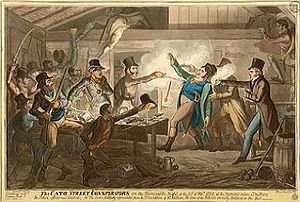
Back مؤامرة كاتو ستريت Arabic Conspiración de Cato Street Spanish Complot de la Rue Cato French Cospirazione di Cato Street Italian Cato Street Conspiracy Dutch Conspiração da Rua Cato Portuguese Cato Street conspiracy SIMPLE
This article needs additional citations for verification. (February 2017) |
| Cato Street Conspiracy | |||
|---|---|---|---|
| Part of the Revolutions during the 1820s | |||
 The arrest of the Cato Street conspirators. | |||
| Date | 22-23 February 1820 | ||
| Location | Cato Street, London | ||
| Caused by |
| ||
| Goals | Overthrow of the Government | ||
| Methods | |||
| Resulted in | Conspiracy foiled | ||
| Parties | |||
| |||
| Lead figures | |||
| Number | |||
| |||
| Casualties | |||
| Death(s) | 1 police officer | ||
| Arrested | 13 conspirators | ||
| Charged | 5 executed 5 exiled | ||
The Cato Street Conspiracy was a plot to murder all the British cabinet ministers and the Prime Minister Lord Liverpool in 1820. The name comes from the meeting place near Edgware Road in London. The police had an informer; the plotters fell into a police trap. Thirteen were arrested, while one policeman, Richard Smithers, was killed. Five conspirators were executed, and five others were transported to Australia.
How widespread the Cato Street conspiracy was is uncertain. It was a time of unrest; rumours abounded.[1] Malcolm Chase noted that "the London-Irish community and a number of trade societies, notably shoemakers, were prepared to lend support, while unrest and awareness of a planned rising were widespread in the industrial north and on Clydeside."[2]
- ^ Elie Halevy, The Liberal Awakening 1815–1930 [A History of the English People In The Nineteenth Century – vol. II] (1949), pp. 80–84.
- ^ Malcolm Chase, "Thistlewood, Arthur (bap. 1774, d. 1820)", Oxford Dictionary of National Biography (2004).
© MMXXIII Rich X Search. We shall prevail. All rights reserved. Rich X Search